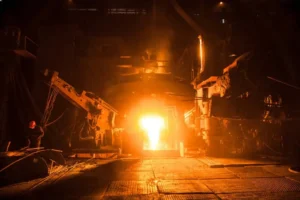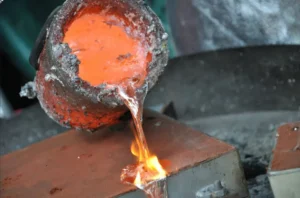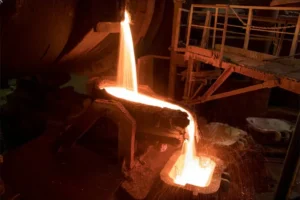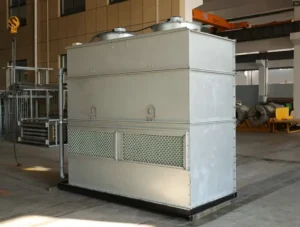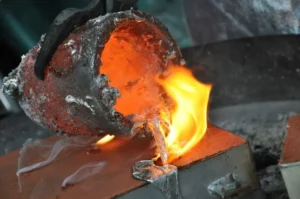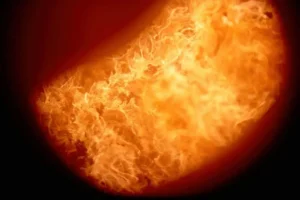দ্রুত দৃঢ়করণ প্রক্রিয়াকরণ (আরএসপি) একটি প্রযুক্তি যা অত্যন্ত উচ্চ শীতল হার ব্যবহার করে (সাধারণত 103 প্রতি 106 K/s or even higher) to rapidly cool liquid metal to obtain metal materials with non-equilibrium organization, fine grains, or even amorphous structures. Amorphous alloys, also known as metallic glasses, are typical products of rapid solidification technology. Their unique atomic arrangement gives them excellent mechanical, physical, and chemical properties.
Due to its unique heating characteristics, induction heating shows great potential in rapid solidification and amorphous alloy preparation.
The advantages of induction heating in rapid solidification and amorphous alloy preparation are reflected in:
- Fast and efficient heating: Induction heating can quickly melt the metal to the required temperature, shorten the melting time, and reduce the burnout of elements, which is crucial for the preparation of amorphous alloys with precise composition.
- Controllable energy input: By adjusting the power and frequency of the medium frequency power supply, the temperature and heating rate of the melt can be accurately controlled to provide stable initial conditions for the subsequent rapid solidification process.
- Crucible-free or cold crucible technology: Induction heating can achieve suspension melting (crucible-free) or melting in a water-cooled copper crucible (cold crucible), avoiding the reaction between the melt and the crucible material and improving the purity of the alloy, which is particularly important for the preparation of high-performance amorphous alloys.
- Easy to integrate with rapid solidification devices: The induction heating system is relatively compact and easy to integrate with various rapid solidification devices (such as injection molding, belt throwing method, atomization method, ইত্যাদি) to achieve continuous operation of melting and rapid solidification.
- Applicable to a variety of alloy systems: Induction heating can be applied to the melting of a variety of metals and alloy systems, providing the possibility of preparing amorphous alloys with different compositions and properties.
Exploration of rapid solidification and preparation of amorphous alloys using মাঝারি ফ্রিকোয়েন্সি আনয়ন গরম.
- আনয়ন গলনা – Melt Spinning/Jet Casting: This is a commonly used method for preparing ribbon or wire amorphous alloys. The alloy ingot is quickly melted in a medium frequency induction furnace, and then the molten metal is sprayed onto a high-speed rotating cooling roller through a nozzle to achieve an extremely high cooling rate. The rapidity and controllability of medium frequency heating help to obtain a uniform melt with moderate superheat, providing favorable conditions for subsequent rapid solidification.
- আনয়ন গলনা – Gas Atomization: After the alloy is melted in a medium frequency induction furnace, it is sprayed with high-pressure gas (যেমন আর্গন, নাইট্রোজেন) to atomize into fine droplets. These droplets are rapidly cooled and solidified during flight to obtain amorphous or microcrystalline powders. The crucible-free or cold crucible characteristics of medium frequency induction heating can reduce melt contamination and improve the purity of the powder.
- আনয়ন গলনা – Copper Mold Casting: For the preparation of bulk amorphous alloys, induction heating is sometimes used to melt the alloy, and then the melt is quickly poured into a copper mold with good thermal conductivity. Although the cooling rate is relatively low, it is still possible to obtain amorphous or nanocrystalline structures of a certain size by optimizing the alloy composition and mold design.
- Induction Levitation Melting – Rapid Solidification: The molten metal is suspended by electromagnetic force, completely avoiding contact with the crucible, and then rapid solidification is achieved by cutting off the suspension current or injecting cooling gas. This method can produce high-purity amorphous alloys, especially for alloy systems that are sensitive to crucible reactions.
চ্যালেঞ্জ
Although induction heating has significant advantages in rapid solidification and amorphous alloy preparation, it also faces some challenges:
- Obtaining sufficiently high cooling rates: The preparation of completely amorphous alloys usually requires extremely high cooling rates, which remains a challenge for some bulk materials. How to further increase the cooling rate and apply it uniformly to a larger volume is a key research direction.
- অপ্টিমাইজেশন design of alloy composition: The forming ability of amorphous alloys is closely related to the composition of the alloy. It is necessary to design an alloy system with good glass-forming ability to obtain an amorphous state at a relatively low cooling rate.
- Precise control of process parameters: Medium frequency heating power, ফ্রিকোয়েন্সি, melt superheat, and parameters such as injection pressure and cooling medium temperature during rapid solidification need to be precisely controlled to obtain the desired microstructure and properties.
- Cost and efficiency of large-scale preparation: Expanding laboratory-level rapid solidification and amorphous alloy preparation technology to industrial production requires consideration of cost, efficiency and product quality stability.
ভবিষ্যত আউটলুক
With the continuous development of induction heating technology and rapid solidification technology, as well as in-depth research on the properties of amorphous alloys, it can be foreseen that induction furnaces will play an increasingly important role in the preparation of high-performance amorphous alloys and metal materials with special structures in the future.
New induction heating methods, more efficient rapid solidification devices, and more optimized alloy composition designs will jointly promote the development of this field and provide key material support for high-tech industries such as aerospace, biomedicine, and electronic information.
Induction heating provides an efficient, controllable and potential technical approach for rapid melting and solidification of metals, especially for the preparation of amorphous alloys with unique properties. By continuously overcoming technical challenges, we are expected to use induction furnaces to create more new metal materials with breakthrough performance.


